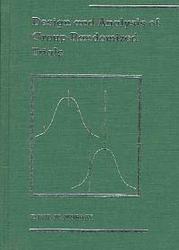Description
This is the first comprehensive text on the design and analysis of group-randomized trials. It collects information previously scattered among journals and texts in a variety of disciplines, and, in addition, presents much new material not available elsewhere. The book has been written to help those involved in these trials improve their ability to plan, fund, conduct, analyze, and interpret them, and to give students a detailed understanding of the field. Group-randomized trials are comparative studies in which the units of assignment are identifiable groups and the units of observation are members of those groups. The positive intraclass correlation expected among the members of each group poses unique and challenging issues for the design and analysis of these trials and separates them from the traditional clinical trial. After reviewing the underlying issues, Murray presents the research designs that are most widely used in group-randomized trials, together with their strengths, weaknesses, and appropriate applications. He describes the many approaches to analysis that are now available, presents mixed-model regression analyses appropriate to each design, and illustrates them using data from the Minnesota Heart Health Program. He also covers methods for estimating sample size, detectable difference, and power. This volume is not limited only to a conceptual treatment of the issues and solutions. It offers a review of the practical applications in a series of case studies, examples, and problems.
